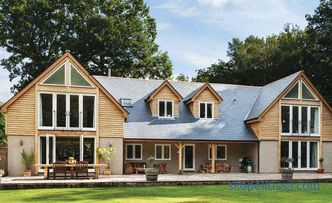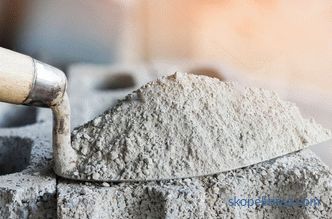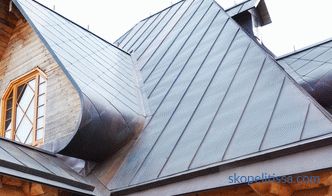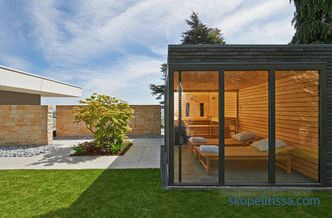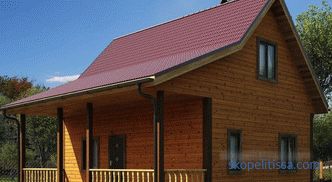The subject of the article is "finishing the facade with a clinker tile". This building material is very popular today. On the market it is represented by a huge variety of sizes, shapes, decorative filling. Who has already encountered clinker, he knows well why he is so popular. Therefore, the article will tell about the clinker tile, its technical and operational characteristics, the advantages of this material and its disadvantages, as well as the ways of finishing the facades of buildings and structures.
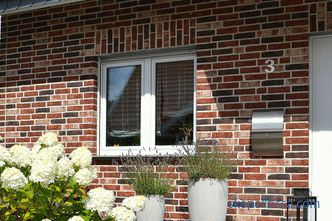
What is a clinker tile
Immediately need to say that this ordinary pottery. That is, molded clay, which is calcined at a temperature of + 1200-1400С. It is the firing and gives the finishing material increased strength and high waterproofing qualities. In addition, the clinker tile has other characteristics, they are its advantages:
-
it easily transfers quite serious temperature drops ;
-
this is cold-resistant material;
-
the sun's rays do not affect the finish of the house, that is, the facade will always be in its original condition, especially with regard to decorativeness walls;
-
such facing is inert to the influence of chemically active substances ;
-
material is environmentally pure;
-
huge assor the time of color design, plus, variety of textures that will satisfy even the most demanding consumer;
-
lifetime - not less than 100 years .
As for the flaws, there are only two of them:
-
Clinker tiles - the material is quite fragile . When falling, it just splits , therefore when carrying out finishing work it is necessary to work carefully .
-
The price of the finishing material is not the cheapest , of course, compared to other facade finishing technologies.
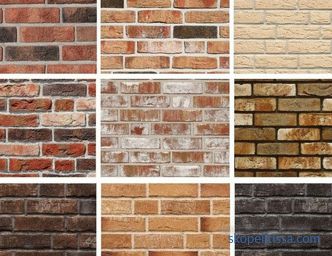
And one more thing that can be attributed to the benefits. This is a small thickness of the cladding, and accordingly a small weight of finished products. That is why there is no need for a clinker finish to build an additional base. That is the brick tile does not load neither walls of the house, nor its base.
A consumer survey revealed that the main reason for the popularity is the similarity of the brick tile with brick trim. But the tile has one advantage over the brick - it can be cladding with any facades built from any building materials. What can not be said about the brick. In addition, clinker is a great choice for color design. Here the colorful palette is diverse, and there are practically no restrictions on the manufacturers.
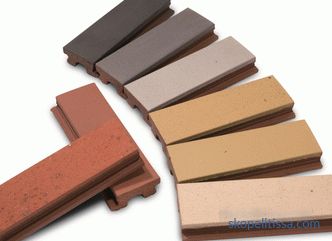
As for the texture, this and smooth bricks, and with a rough surface, and with a relief with the addition of inclusions from other building materials. There are even tiles that have brilliant additives. The most important thing when choosing is to realize that sometimes the appearance of the tile in the store is completely different when it is lined with a house wall. And this must be taken into account. That is why many salespeople and specialists recommend using the services of professional designers who have had experience with the finishing of the facades of houses with exactly clinker tiles.
And one more thing that was mentioned above. This is a high price item. The production process of this building material is associated with such a rather energy-intensive procedure as firing. Therefore, the clinker tile is not cheap. And, if the market offers you an inexpensive material, then surely it was made with violations of the technological cycle. There is no other explanation.
Technology of laying clinker tiles
In principle, Clinker facade cladding technology is standard. That is, it is exactly the same as, for example, facing with bricks or ceramic tiles. But, as always, the first moment with which to start finishing is to make an exact calculation of the required amount of material. And since the external walls of a house are not only their planes, but also the corners of a building, one has to calculate the required number of ordinary, so to speak, ordinary tiles, and corner elements.
The first ones are calculated based on the area of the walls to be lined, the second - the lengths of the corners of the house. For the first it is necessary to multiply the length of the walls by their height. And for the second, only height is required. Then in the first case, the area of one tile is determined. And then the total area of the walls is divided into its area.In the second case, the total value of all corner lengths is divided by the width of the corner element.
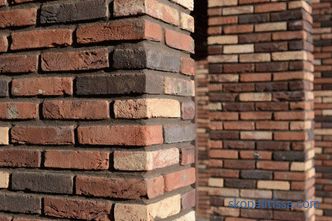
On our site you can familiarize yourself with the most popular house projects from the best construction companies with an impeccable reputation in the market. You can choose a house without finishing the facade, or with clinker thermopanels, or from any other modern building material. Directly to communicate with representatives, you can visit the exhibition of houses "Low-rise Country".
Surface preparation for tiles
The wall surface, on which it is planned to lay the clinker tiles, should be durable, dry and with a slight plane difference. Therefore, the optimal wall - plastered or concrete. If a wooden house or a frame, sheathed with plywood or OSB boards, is chosen for finishing, then you will have to fill a plaster grid on the walls, which will act as a reinforcing skeleton for future finishing.
To fix the tile to the wall, use a standard adhesive composition, which is used for lining with bricks or tiles. There are other technologies that use special metal brackets.
Today, in an age of total savings, it is necessary to take into account the thermal insulation qualities of the finish. Therefore, it is often the case that a heat-insulating layer is laid under the clinker tile, more often a panel of foamed polystyrene. They are fixed to the walls with special dowel-nails made of plastic. This fastener is often referred to as a plate plug. After laying the insulation stretch the plaster grid. It may be steel or synthetic. And already from above they carry out the installation of clinker material.
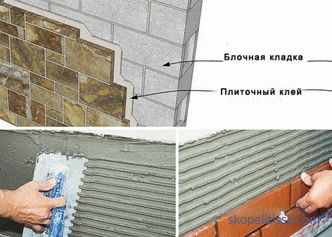
Rules and nuances of cladding
First of all, they are facing the perimeter window and door openings. Then, starting from the first bottom row, fill the planes of the walls. Immediately assemble the corner trim elements. It is very important - it is impossible to carry out laying simultaneously in several rows. Usually five to six rows is normal. If you exceed their number, then the upper ones with their mass can crush the lower ones.
And a few more recommendations:
-
adhesive solution it is necessary to prepare in advance to the required volume masonry;
-
usually the clinker tile fits onto the walls with gaps between the elements, so it is important to choose the correct grout ;
-
width gaps - no more than 1.5 cm;
-
you can not fill the seam to the front surface of the finishing material, you need to leave a small recess in 3 mm for troweling ;
-
adhesive solution is applied to the wall with a notched trowel , as well as on the rear The bottom side of the tile with the usual ;
-
is ideal if the wall before laying the tile mark ;
-
it is not recommended to facing in rainy weather ;
-
if there is a need To cut finishing material, it is better to do a grinder with a diamond cutting disc.
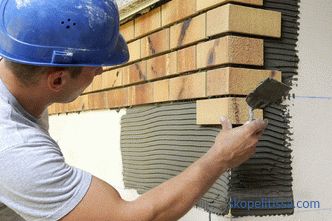
The most popular manufacturers and construction companies are gathered at the exhibition and presented at our site. Here you can find contacts, choose and order any service, among which is the completion of unfinished houses, extensions to existing houses, house insulation. Directly to communicate with representatives, you can visit the exhibition of houses "Low-rise Country".
Innovative technologies
Today, in an age of new technologies and the latest building materials, manufacturers of clinker tiles offer a completely unique kind of it, called thermal panels. This is the tile itself, which is glued to the heat-insulating material, and specifically to the polystyrene foam plates. The latter are cut out specifically for the dimensions of several tiles in the form of panels, which, when connected to each other, form a sealed layer on the wall without seams and crevices.
Today there are two types of thermopanels on the market:
-
Already finished products, which were mentioned above. This is a clinker tile, glued to polystyrene foam panels.
-
Separate option, which is sold as set . It includes a separate insulation , a separate clinker tile . The first is clipped under a certain shape and dimensions of a heat-insulating panel of a material . In them, the method of stamping made places of installation of finishing material.It turns out that first the insulation is mounted on the wall , and the brick tile is glued to it.
We offer to see how the installation of thermopanels is carried out on the front wall of a private house:
This may be interesting! In the article on the following link read about the cost of cladding the facade with clinker tiles.
It may seem that there is nothing complicated. But with seeming simplicity, this is, in fact, a difficult process. The fact is that before beginning the finish, the wall surface should be well leveled, because large differences with this material cannot be closed. It turns out that the main process will be the alignment of the wall.
Recently another type of finishing material appeared on the market. It is three-layered, that is, clinker tiles glued to the polystyrene foam panel. But the latter is attached to the plate OSP. You can add that in this way, manufacturers began to solve the problem of increasing the strength of the base. But not only that. This kind of thermopanels makes it possible to veneer the facades of houses in the so-called "dry" way. That is, with the installation on the frame (crate). For example, the photo below shows how thermopanels trim the front walls of a house from a bar.

It may be interesting! In The article on the following link read about a stone or wooden country house - what to choose.
Thus, it became possible to finish the facades of houses built not only from brick, blocks or concrete. And this is another aspect of the uniqueness of the clinker tiles glued to the insulation panel. In fact, a ventilated facade is assembled on the wall. In addition, it is possible to increase the thermal insulation characteristics of the lining, if an additional layer of thermal insulation material is laid under the thermal panels and the frame. Usually they do.
Ventilated facade technology using thermopanels is recommended to be used when the surfaces of the facade walls have large plane drops. Because the frame can smooth out any unevenness.
The advantages of thermopanels include the following:
-
Beautiful appearance with a huge variety of decorative designs.
-
Lifetime is not less than than the clinker tile itself.
-
A small specific weight that does not put pressure on the walls and foundation of the house.
-
The use of thermopanels is both facing the facade, and insulating the house outside.
-
Conduct installation processes can be at any time years.
-
Simplicity maintenance.
-
The presence of not only ordinary panels , but also corner , which makes it possible to get one hundred percent completeness of the cladding.
The specialist talks about the characteristics of the clinker tile, its advantages and disadvantages in a video:
This can be interesting! In the article on the following link read about the cottage on the hillside in the pine forest near Lake Flathead, Montana.
Conclusion on the topic
So, we have tried to reveal the theme of finishing the facade of a private house with clinker tiles. I would like to draw your attention to the fact that, with the high price of the clinker tile, this finishing material is today at the peak of popularity among country builders. And the fault is the excellent characteristics of this material. In addition, who wants to get a high quality facade finish with a long service life, he chooses the clinker facing.
